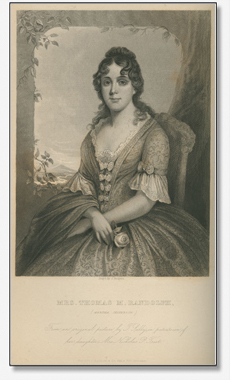
Rufus W. Griswold, The Republican Court, or, American Society in the Days of Washington. New and rev. ed. (New York, 1856), plate opposite 219. First ed., 1855.
MARTHA JEFFERSON RANDOLPH (1772-1836) Martha (“Patsy”) Jefferson was born at Monticello in Albemarle County, Virginia, one of the six children of Thomas and Martha Wayles Jefferson.[1] Her mother was the daughter of a wealthy lawyer and her father served numerous functions in the emerging republic, ultimately becoming the third president of the United States.[2] When Patsy was ten years old her mother died, and over the following years she became increasingly close to her father. Due in large part to his influence, Patsy, along with other woman such as Dolley Madison, would come to represent the epitome of social and intellectual womanhood in the young Republic.[3] In 1784 Patsy accompanied her father to Paris where she attended the prestigious Abbaye Royale de Panthémont convent school.[4] During these years in Paris, she emerged as a cultivated young lady, well educated and experienced in the arts[5]; in 1789 she was brought out into Paris society, surrounded by suitors, at the brilliant but doomed court of Louis XVI.[6] Later that year Patsy returned to Virginia with her father and subsequently married her second cousin, Thomas Mann Randolph (1768-1828).[7] Like her father, she would take the education of her eleven children seriously, establishing a school on the grounds of her home to educate them in “mathematics, history, literature, music and languages.”[8] Throughout her life Patsy Randolph moved in a variety of intellectual and social settings.[9] No stranger to the formal courts of Europe, she was equally at home in the relaxed atmosphere important to her father’s democratic views.[10] Jefferson sought to establish a presidential culture that more resembled life on Virginia plantation, and abolished the elegant “levee” receptions of the presidencies of Washington and Adams.[11] Patsy served as hostess for her father on numerous social occasions during his presidency,[12] and worked to implement her father’s casual style by calling first on socially prominent women new to the capital instead of expecting them to call upon her.[13] Patsy was significant in the history of the early Republic in part because she embodied the era’s ideal of female civic virtue.[14] After her father retired from public life she moved into Monticello with him, where she continued to preside as mistress of the house even while her husband served as governor of Virginia.[15] She was forced to sell Monticello after her father’s death in 1826, and died ten years later at the age of sixty-four.[16] She is buried next to Thomas Jefferson at Monticello.[17] Written by Janet Hallahan. [1] American National Biography, s.v. “Randolph, Martha Jefferson.” [2] Appletons’ Cyclopaedia of American Biography, s.v. “Jefferson, Thomas.” [3] American National Biography, “Randolph.” [4] Notable American Women 1607-1950, s.v. “Randolph, Martha Jefferson.” [5] Ibid. [6] Gordon Langley Hall, Mr. Jefferson’s Ladies (Boston: Beacon Press, 1966), 94; Elizabeth Langhorne, Monticello: A Family Story (Chapel Hill: Algonquin Books, 1987), 36-37. [7] American National Biography, “Randolph.” [8] Ibid. [9] Ibid. [10] Hall, Mr. Jefferson’s Ladies, 158; Langhorne, Monticello, 125. [11] Hall, Mr. Jefferson’s Ladies, 158; Langhorne, Monticello, 125. [12] American National Biography, “Randolph.” Occasionally Dolley Madison would serve as First Lady as well for Jefferson. Margaret Brown Klapthor, “Martha Wayles Skelton Jefferson,” in The First Ladies (Washington: White House Historic Association of the National Geographic Society, 1981), 13. [13] Hall, Mr. Jefferson’s Ladies, 176-77. [14] American National Biography, “Randolph.” [15] Ibid. [16] Notable American Women, “Randolph.” [17] Ibid. |

